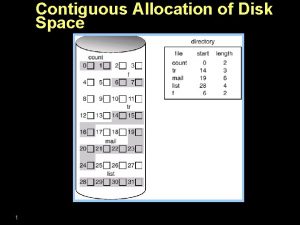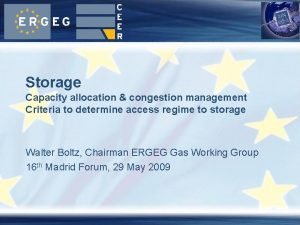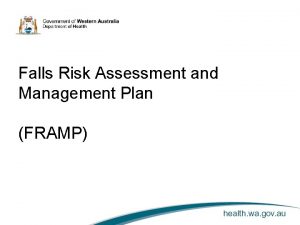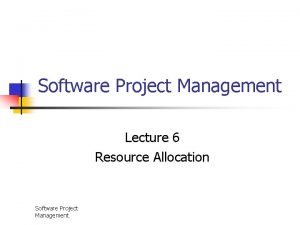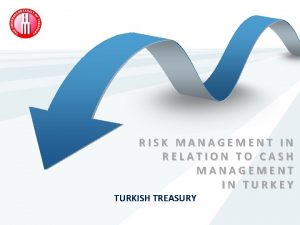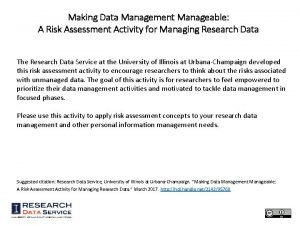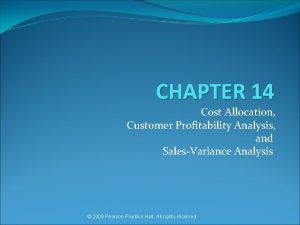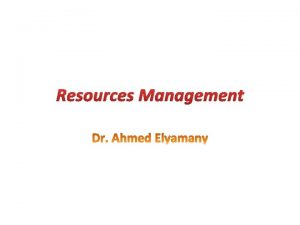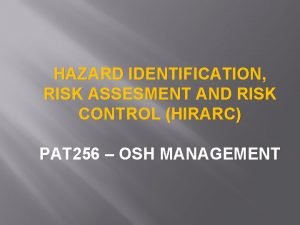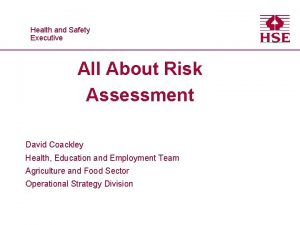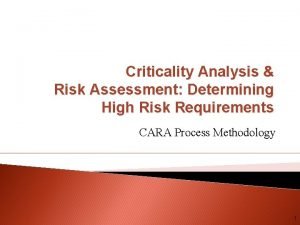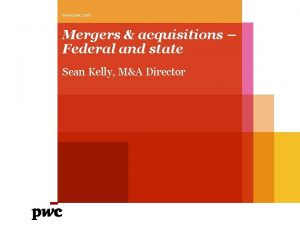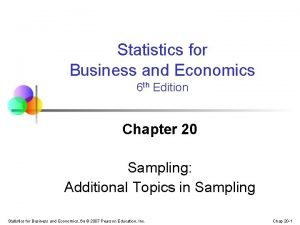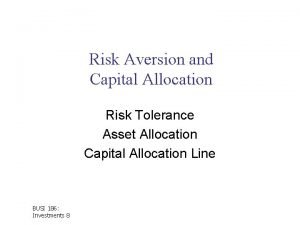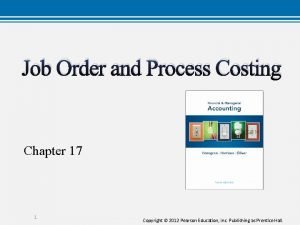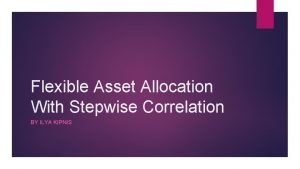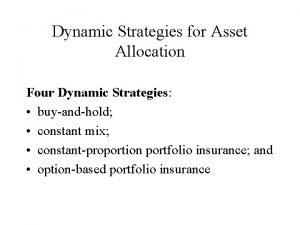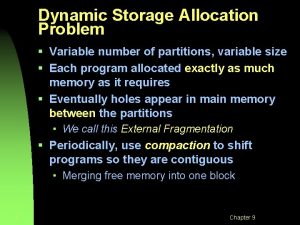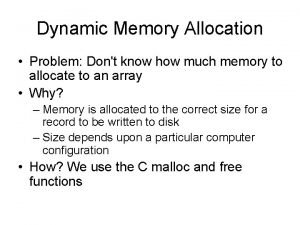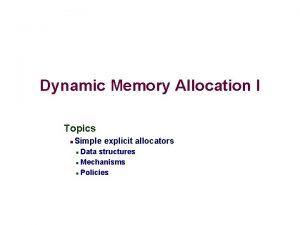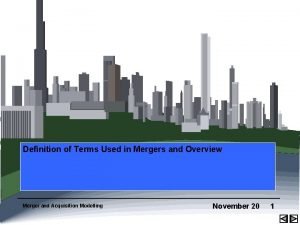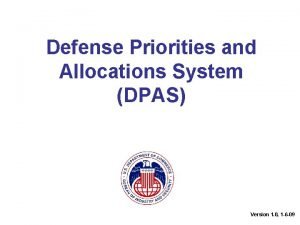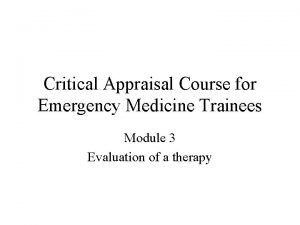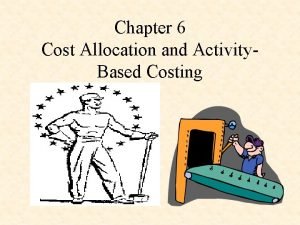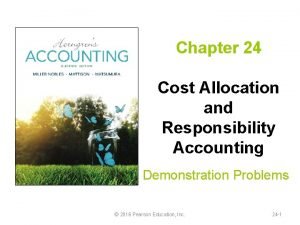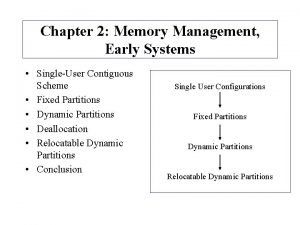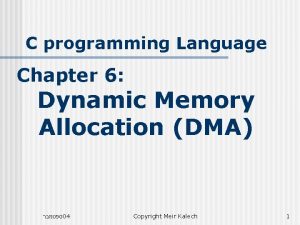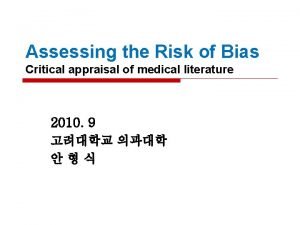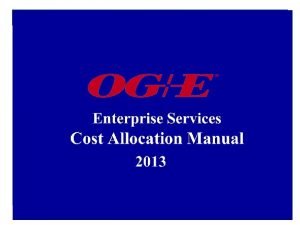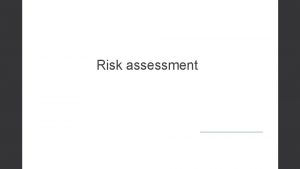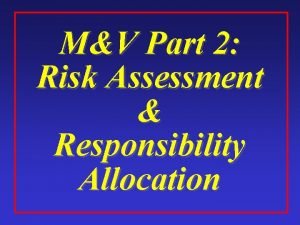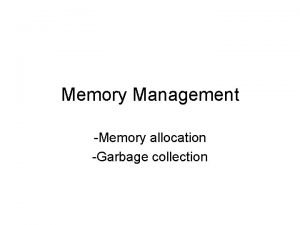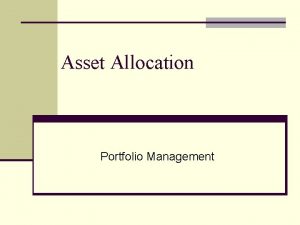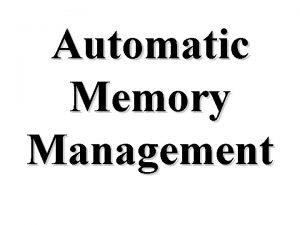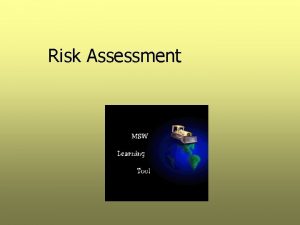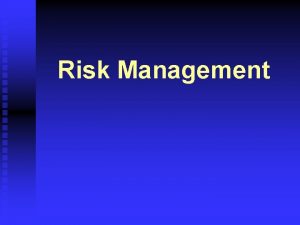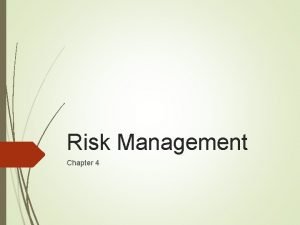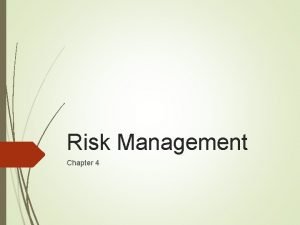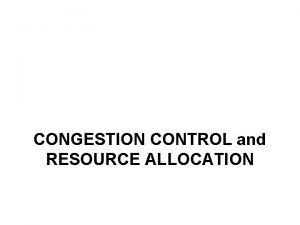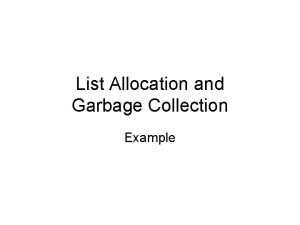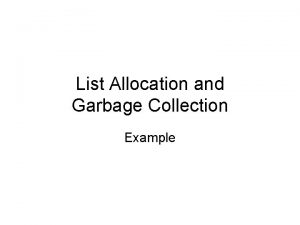Risk Assessment and Allocation Management Risk Assessment What























![[From Pennock and Haimes*] • Four barriers to transfer of risk knowledge – Horizontal [From Pennock and Haimes*] • Four barriers to transfer of risk knowledge – Horizontal](https://slidetodoc.com/presentation_image_h2/e56cf639ab62af155e87abef33c6917f/image-24.jpg)


















































- Slides: 74

Risk Assessment and Allocation – Management

Risk Assessment • What can go wrong? – Risk identification • What is the likelihood? • What are the consequences?

Risk Management • What can be done and what options are available • What are the tradeoffs in terms of all costs, benefits, and risks among the available options • What are the impacts of current decisions on future options.

Chapter 1. Introduction • Procedures for PSE (plans, specifications, and estimates) are standard – Across DOT’s • Treatment of Risks are not standard – Or uniform

Risk Management • • Identification Assessment Analysis Mitigation Allocation Monitoring Updating



Project Phase Status Typical Risk Issue

Objectives for Risk Assessment Expected Outcomes

Terms • Technical Risk – Performance • Programmatic Risk – Cost – Schedule • Contingency – Amount of money or time needed above the estimate to reduce the risk of overruns. . to a level acceptable to the organization

Neat + “contingency” Neat Estimate

Qualifications of RM Team • Early – Environmental planning, funding, operations • Later – Scheduling, cost estimating



But • Output needs to be clear (and simple) • Easily understood by decision-makers • And partners, public, team

Chapter 2. Risk Identification • • Objectives of Risk Identification Identify Risks Categorize Risks Identify “minor” risks – Brainstorming – Later will analyze these and determine if minor • Simple project, red flag list may be sufficient

Cute • Knows • Know-unknowns • Unknown-unknowns • Also, Triggers

Risks • Events that team members determine would adversely affect the project • Examine – Project Description – WBS – Cost Estimate – Schedule – Procurement plan – Checklists

Organize • Classify, groups of like risks – Right of Way issues • Levels – Right of Way • South Park • East Park – Businesses – Parkland reserve – Golf course

http: //creatingminds. org/tools/crawford. htm http: //creatingminds. org/tools/ngt. htm http: //creatingminds. org/tools/delphi. htm http: //en. wikipedia. org/wiki/Scenario_planning

Chapter 3, Risk Assessment • (Chapter 3, qualitative; 4, quantitative) • Qualitatively evaluate risks from Risk Identification. • Systematic consideration of risk events, their likelihood of occurrence, and their consequences.

Nature of Effects • Direct, Organization – Increase cost or schedule • Direct, public – Affect the public, public perception, environmental, health • Indirect – Increased oversight – Planning – Reviews

Managers v. Annalists • Managers tend toward qualitative evaluation – Worst case and likelihood – Avoid risks – Reduce negative impacts • Annalists tend toward quantitative – Range of results – Probabilities – Tend to combine
![From Pennock and Haimes Four barriers to transfer of risk knowledge Horizontal [From Pennock and Haimes*] • Four barriers to transfer of risk knowledge – Horizontal](https://slidetodoc.com/presentation_image_h2/e56cf639ab62af155e87abef33c6917f/image-24.jpg)
[From Pennock and Haimes*] • Four barriers to transfer of risk knowledge – Horizontal • Between subdivisions or specialties, stovepipes – Vertical • Between layers of management, upper, middle and operational – External • Between organizations – Geographic • Distance * Principles and Guidelines for Project Risk Management, M. J. Pennock and Y. Y. Haimes, Systems Engineering, Vol. 5, No. 2, 2002

• Qualitative best for – Screening and prioritizing risks – Developing appropriate risk mitigation and allocation strategies • Quantitative best for – Estimating the numerical and statistically nature of the risk exposure

Risk to whom? • Often several project participants share the risk. • Might maintain the risk or shift it to another party via contract • But owner needs to understand the risks – Consider change order risk

Definitions • Internal risks – Can be referenced to a project documents • Cost estimate, schedule • External risk – Imposed on projects from outside • Citizens groups • Funding restrictions

• Incremental Risk – Small, over the life of project – Most internal risks are incremental – Costs will occur and be different from the estimate • Discrete – Often External – Will occur or not

Model Risks and Data Risks • Aleatory (Data) Risks – Uncertainty associated with the data • Future cost of a material • Epistemic (Model) Risk – Inability to calculate risk • Number of passes required to compact – Despite knowing soils data.

Organize Data and Decide • Ordinal Risk Matrix • Decision tool

Ordinal Risk Matrix

Chapter 4 – Risk Analysis • Take qualitative risks – Surely high – Probably moderate • Do a quantitative analysis – Often, cost and schedule

Many methods • Should include explicit knowledge of team • Allow quick response to changing markets and conditions • Determine project cost and schedule contingency • Help foster clear communications among team and higher about uncertainties • Should be easy to understand


Technical Risks • Reliability • FMEA – Failure modes and effects analysis • Fault tree analysis • (Here we will spend most time on cost and schedule)

Input Parameters • Probability distributions – Continuous – Discrete – Point

Output • Depends on use • Simple mean (w or w/o SD) – Of many projects in next years budget • Distribution – Useful for assigning contingency •

Sensitivity Analysis • Test how sensitive result is to change in variables

Estimate Factors • Increase estimate for certain items • Low percent for items that do not vary much in cost • High percent for items that usually vary • Problems – Not project specific – Don’t think – Does not identify risk drivers • Mitigation


Analytical Methods • Last week • Beta distribution

Monte Carlo • With Crystal Ball is easy • Needs definite input parameters • Better mousetrap

Others • Decision Trees • Useful • Model conditional probabilities among project variables • Examples

Schedule • • CPM Critical path can change Can work in MS Project with Beta Or set up in Excel/Crystal Ball

Chapter 5, Risk Mitigation and Planning • Follows qualitative and quantitative risk analysis • Identifies and assigns parties to take responsibility – For each risk response • Ensures each risk requiring a response has an “owner”

Risk Response Options • Unrecognized, unmanaged, or ignored • Recognized but no action – Absorbed as a matter of policy • • • Avoided by taking appropriate steps Reduced with alternative approach Transfer via contract or insurance Retained and absorbed by prudent allowances Combination of above

Risk Planning • Appropriate risk response strategies • Iterative through the job • Large projects with high degree of uncertainty need formal risk management plan.

• Assign responsibilities for specific areas • Identify additional technical expertise needed • Describe assessment process and areas to consider • Delineate procedures for consideration of mitigation and allocation options • Dictate reporting and documentation needs • Establish report requirements and monitoring metrics

• But will vary with size, complexity, and uncertainty of project. • See Cal. Trans Excel files.

Red Flag List • See several, Caltrans for example • Identify items • Focus attention on critical items that can affect cost and schedule • Need to update

Risk Charter • Gives managers list of risks and possible cost and schedule impacts • It is a management tool to identify, communicate, monitor, and control risks • Helps set contingencies

List for each risk • • • Description Status Project phase Functional assignment Risk Trigger Probability Impact ($ or time) Response actions Responsibility (task manager)

Formal Risk Management Plan • Large, complex, uncertain projects • Often with management contractor


Chapter 6 – Risk Allocation • Goals 1. Allocate risks to party best able to manage them 2. Allocate risks in alignment with project goals 3. Share risk when appropriate 4. Allocate risks to promote team alignment with customer-orientated performance goals

1. Party best able to manage • Contractor – Labor force, equipment breakdown, construction technique • Owner – Project funding, site availability • Differing Site Conditions – Owner • “Inappropriate risk shifting can result in misaligned incentive, mistrust, and increased disputes. ”

Alignment with Project Objectives • Public needs project completed on short schedule – Increase LD? • Understand objectives early and refer to them at all important project decisions. • Examples of objectives


Risk Sharing • Risk is not really “shared” • It is split among the parties • Adverse weather – Excusable not compensable delay – Delay by owner – Cost by contractor

Example • Claims on drilling of shafts for bridge piers due to small boulders. But sufficient equipment could handle • Owner could – Specify equipment • Which has its risks too – Pass risk to contactor • No DSC for small boulders • Non-traditional risk sharing should be explained to contractors

Alignment with Customer. Orientated Performance Goals • Customer goals – Satisfaction with product – Satisfaction with service – Predictability of time – Predictability of cost, safety • Other goals – Mine – Agencies'

Innovations • • A+B procurement Lane Rental Warranties Examples


Novel – Shared Contingency • Set $500, 000 aside for boulders • Contractor can use up at his unit rates • Owner and contractor spilt remaining 5050 • This is more profitable than the profit in his unit rates • ? ?

• Contractor and supply chain are more likely to contribute to the effective and efficient management of risks if they have fair and reasonable incentives • Risk of fuel price escalation

Chapter 7 – Risk Monitoring and Updating • • • Objectives: Systematically track the identified risks Identify any new risks Manage the contingency reserve Capture lessons-learned

• Tasks • Develop consistent and comprehensive reporting procedures • Monitor risk and contingency resolution • Provide feedback of analysis and mitigation for future risk assessment and allocation.

Reporting • Formal? – Tends to ensure more comprehensive assessments • Distinguish from Project Control – Cost – Schedule – Production – These focus on what has happened relative to plan

• Part of other reports – monthly • See Fig 22, page 39




Contingency Funds • Track and Manage • Contingency should be matched to underlying risks • Which changes over time • La La Land? – Manager will try to hold on to contingency – May not be able to transfer between projects

Estimates, Risk, Public Trust • Public perception – Projects grossly over budget – Waste or incompetence? – Dishonesty • Low-ball estimates? • Explain project risks? • http: //www. tfhrc. gov/pubrds/04 jul/03. htm
 Linked allocation
Linked allocation Capital allocation between risky and risk free asset
Capital allocation between risky and risk free asset Risk allocation in project finance
Risk allocation in project finance Market risk assessment
Market risk assessment Capacity allocation and congestion management
Capacity allocation and congestion management Framp chart
Framp chart Population health risk assessment and management
Population health risk assessment and management Software project management resource allocation
Software project management resource allocation Key risk indicators template
Key risk indicators template Risk map risk management
Risk map risk management Cash management risk assessment
Cash management risk assessment Contract management risk assessment matrix
Contract management risk assessment matrix Data management risk assessment
Data management risk assessment Contract management risk assessment matrix
Contract management risk assessment matrix Resources allocation and mobilization plan (ramp)
Resources allocation and mobilization plan (ramp) Davis and moore role allocation
Davis and moore role allocation Disadvantages of static memory allocation
Disadvantages of static memory allocation Cost allocation and profitability analysis
Cost allocation and profitability analysis Resource allocation and scheduling
Resource allocation and scheduling Resource allocation graph and wait for graph
Resource allocation graph and wait for graph Efficient capital allocation
Efficient capital allocation Overhead allocation and apportionment
Overhead allocation and apportionment Global order fulfillment
Global order fulfillment Residual risk and secondary risk pmp
Residual risk and secondary risk pmp Business risk and financial risk leverage
Business risk and financial risk leverage Relative risk calculation
Relative risk calculation Attributable risk (ar)
Attributable risk (ar) Hirarc full form
Hirarc full form Health and safety risk assessment template
Health and safety risk assessment template Criticality analysis and risk assessment
Criticality analysis and risk assessment Top management middle management first line management
Top management middle management first line management Top management middle management first line management
Top management middle management first line management Top management and middle management
Top management and middle management Purchase price allocation pwc
Purchase price allocation pwc Overhead allocation
Overhead allocation Turn constructional component
Turn constructional component Buddy memory allocation
Buddy memory allocation Cloud cost allocation
Cloud cost allocation Capital allocation line
Capital allocation line What is proportional allocation
What is proportional allocation Spectrum allocation
Spectrum allocation Capital allocation line
Capital allocation line Allocation concealment
Allocation concealment Railroad
Railroad Memory management in os
Memory management in os Heap allocation
Heap allocation What's wrong in the picture
What's wrong in the picture Industrial estate in entrepreneurship development
Industrial estate in entrepreneurship development Pengertian pointer
Pengertian pointer Econophysics
Econophysics How to calculate predetermined overhead allocation rate
How to calculate predetermined overhead allocation rate Industrial area definition
Industrial area definition Flexible asset allocation
Flexible asset allocation Dynamic strategies for asset allocation
Dynamic strategies for asset allocation Dynamic storage allocation problem in os
Dynamic storage allocation problem in os Example of dynamic memory allocation
Example of dynamic memory allocation Dynamic memory allocation in data structure
Dynamic memory allocation in data structure Tcmalloc
Tcmalloc Example of dynamic memory allocation
Example of dynamic memory allocation Dynamic data structure
Dynamic data structure Departmental purchases account
Departmental purchases account Purchase price allocation example
Purchase price allocation example Defense priority allocation system
Defense priority allocation system Allocation concealment
Allocation concealment Spectrum allocation
Spectrum allocation Resource leveling is the approach to even out the peaks of
Resource leveling is the approach to even out the peaks of First stage allocation
First stage allocation Incremental revenue allocation method
Incremental revenue allocation method Predetermined overhead allocation rate
Predetermined overhead allocation rate Single user contiguous storage allocation
Single user contiguous storage allocation Dynamic memory allocation in data structure
Dynamic memory allocation in data structure Dynamic c programming
Dynamic c programming Dynamics 365 lead auto allocation
Dynamics 365 lead auto allocation Allocation concealment
Allocation concealment Behavioral bliss point approach example
Behavioral bliss point approach example
